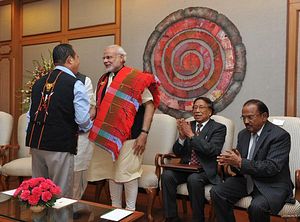In an unexpected and sudden development, the Indian government announcement on Monday evening that it had signed a historic agreement with the Naga rebels in the country’s Northeast, thereby ending the six decade old insurgency in the region. The peace accord was announced jointly by none other than Prime Minister Narendra Modi and Thuingaleng Muivah, leader of the Nationalist Socialist Council of Nagaland (Isak-Muivah), know as the NSCN(IM) for short. Muivah is one of the leaders of the NSCN(IM). The other leader, Isak Chisi Swu, is on his deathbed.
Since 1997, the main Naga insurgent group, NSCN(IM), has been involved in a ceasefire agreement with the Indian government. For nearly 20 years, both sides have been engaged in a protracted discussion regarding a final accord.
The main demand of the rebel Naga group has been the creation of “Nagalim,” a Greater Nagaland, comprising all the Naga-dominated areas in the Indian Northeast, creating a separate state. The movement started with the demand for total sovereignty in the 1950s, but over the years, the group has scaled down its demands.
The government has not yet released the final text of the accord, giving wings to all kinds of speculation and questioning from the Indian media.
The main sticking point in the talks that led up to this accord was the reluctance of the Naga group to accept the Indian constitution and carve out a Greater Nagaland. But in 2012, the Naga faction agreed to find a solution to the problem within the framework of the Indian constitution. But there was stridency on the part of the rebels for a Naga state, comprising all the Naga-dominated areas of the Northeast.
In 1963, the Indian government carved out the state of Nagaland around the region’s predominantly Naga population as its main inhabitants. However, this did not satisfy the Naga insurgents, who saw the move as an attempt to divide the Naga tribes living in different parts of the Northeast. That sparked a struggle to bring all the Naga areas, which fall in other states of the Indian Northeast, including Assam, Arunachal Pradesh, and Manipur under one geographical boundary. In essence, this was their demand for a greater Nagaland.
However, other states are not willing to concede their territory to the Nagas. Here lies the trick. If the demand for Nagalim is conceded by the central government, it would open a Pandora’s Box and lead to political chaos in the region.
Will the NSCN(IM) settle down without realizing its major demand through this accord? What kind of political arrangement has the Modi regime agreed to with the rebel group?
“Everybody is waiting and watching with one question: what is in the agreement? Peace is a good thing, but people want to know what is there in the deal that has been signed. Why was the Nagaland chief minister not there when the deal was being announced?” asks Sanjoy Hazarika, director of the Center for Northeast Studies and Policy Research at New Delhi’s Jamia Milia Islamia University.
In the absence of details, many questions are being raised about the accord.
Peace talks in Nagaland have a chequered history.
In 1975, six rebel Naga groups signed an accord with New Delhi with a view to finding ways to reach a final settlement but that agreement fell through when hardliners in the present Naga leadership, Muivah and Swu, opposed any compromise. Subsequently, they formed the NSCN.
The NSCN also saw a division on the question of talks with the Indian government in 1988, with the hardline leader, S. S. Khaplang, forming the NSCN(K) branch and moving his base to Myanmar. Since 1997, the Isak-Muivah group has been under a ceasefire agreement with New Delhi. Khaplang’s group also came to an informal ceasefire agreement in 2000. However, the NSCN(K) ended the ceasefire unilaterally few months ago.
The present Naga leadership of the NSCN is old and has been struggling for quite some time to keep its supporters motivated. Their credibility lies in the finer print of the agreement. With the Indian prime minister himself announcing the agreement, the NSCN supreme leaders would like to showcase it as a major achievement.
However, they also run the risk of alienating themselves from a new generation of Nagas. If the accord does not give an honorable exit for the rebellion, the Khaplang faction will surely stoke anti-India sentiment in the region and encourage the Naga youth to pick up arms against the central government.
The prestige of the Indian government is also at stake. If New Delhi fails to deliver what it promised to the Nagas, it will hurt their sentiments; that might also lead to a resurgence of the armed rebellion.
Therefore, the Naga accord is a double edged sword: it can either bring permanent peace to a long troubled region, or it can lead to an escalation of tensions in the Indian North East.
































